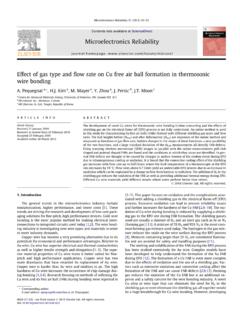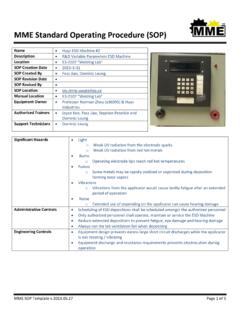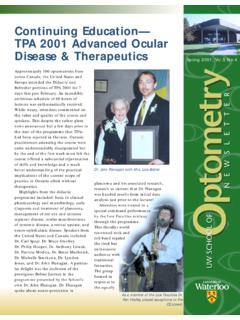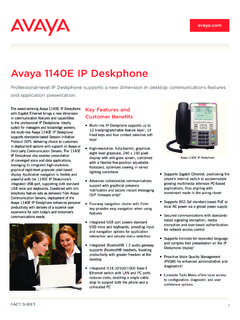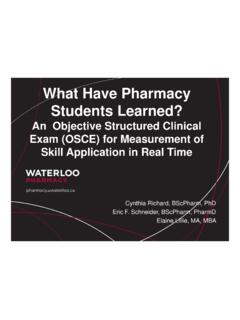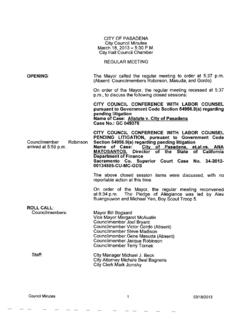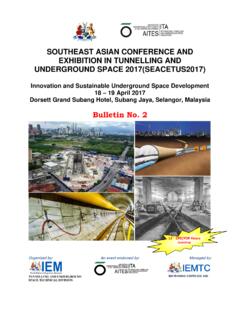Transcription of CPATT NEWS - University of Waterloo
1 May 2012 | CPATT | CPATT news Message from the Director Contents Research Focus Laboratory 3 Structures/Concrete 4 CPATT Field Work 5 Individual Highlights Feature CPATT Faculty 2 Feature Student/Project 7 Test Track Turns 10! 8 TRB Hospitality Suite 11 Chang an University Visit 12 Girl Guides Badge Day! 13 Speakers Corner 14 Upcoming Events 18 Welcome New Students 18 Past Seminars 18 This is a very special issue of our newsletter as the CPATT Test Track is 10 years old in June 2012. It is truly hard to believe the last decade has gone so quickly! It has been an excellent research and education tool. This issue provides some of our typical updates but the bulk of the issue focuses on the lessons learned from our Test Track.
2 In addition, we have featured many of our former students and asked them what they have learned from their time at CPATT . Enjoy! If you would like to learn more about anything we have presented in this newsletter, please do not hesitate to contact either Laura Bland at or Susan Tighe at We look forward to hearing from you! Sincerely, Susan L. Tighe, PhD., PEng. Issue 5 Feature CPATT Faculty Member Sriram Narasimhan, PhD., Assistant Professor 2 Education Dr. Narasimhan is an Assistant Professor in the Department of Civil and Environmental Engineering at the University of Waterloo . He joined the Department in 2006 after completing his PhD at Rice University in Houston, Texas, USA. Sriram has worked for several years in the consulting industry with the American Bureau of Shipping in the Risk Consulting Division.
3 His MEng degree was in Hydraulics from the Asian Institute of Technology and his undergraduate degree in Civil Engineering from Osmania University in Hyderabad, India. S r i r a m N a r a s im h a n , P h D . , P E n g , A s s is t a n t P r o f e s s o r , D e p a r t m e n t o f C i v il a n d E n v ir o n m e n t a l E n g i n e e r in g , U n i v e r s it y o f W a t e r l oo Research Hi ghli ghts Sriram s research focus is on infrastructure condition assessment and infrastructure protection using novel system identification and structural control methods. He has several peer-reviewed publications in the area of protection of structures using seismic dampers and tuned mass dampers to withstand natural hazards such as earthquakes and windstorms.
4 His work in the area of system identification has resulted in several novel algorithms to estimate the properties of buildings and bridges. His algorithms in the area of signal processing have shown significant potential for use with wireless sensor networks for cost-effective and rapid infrastructure condition assessment. He is currently working with researchers within UW as well as around the world to develop vibration mitigation methods aimed at enhancing the performance and comfort of pedestrians in light-weight aluminum and stress ribbon bridges. Professional A ctivit y Highl ight s Sriram is an active champion and has led efforts to enhance the visibility of issues surrounding aging infrastructure and to develop cost-effective mitigation solutions using control devices.
5 He currently serves on three international journal editorial boards, and is an active reviewer for over a dozen journals. Recipient of the Distinguished Performance Award (2011) from the UW Faculty of Engineering, and has been nominated three times in a row for the Research Excellence Award in the Assistant Professor category in the department of Civil and Environmental Engineering. Sriram has been prominently featured as an expert in the media in the aftermath of recent earthquakes such as the ones in Japan and Haiti. 3 Research Focus John J. Carrick Pavement Laboratory Joshua Stipancic (co-op) with the aggregate prior to sieving Sieving approximately 5 tonnes of material Xiomara Sanchez (PhD Candidate) adding asphalt cement during mixing process Md.
6 Safiuddin (Post-doc) running the Asphalt mixer Laboratory Updates Great progress has been made on the recycled asphalt pavement (RAP) project over the past few months, which is being funded in partnership with the Ministry of Transportation Ontario and the Ontario Hot Mix Producers Association. The CPATT team is also working in partnership with DBA Engineering. Approximately 5 tonnes of material was sieved in preparation for the batching and mixing process. In addition to sieving, mixing has begun in the CPATT laboratory. To date, four of the proposed RAP mix designs have been completed, with 290kg of material prepared for each mix type. The separated aggregate was batched together in precise proportions according to the mix designs. The aggregate batches were then combined with asphalt cement to create the raw asphalt material.
7 Two remaining mix designs are scheduled to be completed by the middle of May. Following batching, tests were performed to determine the maximum relative density of the mixes. Thus far, all results have fallen within an acceptable range, and the lab created mixes are matching the specifications of the mix designs. Following the completion of the remaining mix designs, samples will be created and laboratory testing of the materials will begin. Results of the study are being incorporated into an upcoming Canadian Technical Asphalt Association (CTAA) paper. 4 Research Focus Structures & Concrete Lab Structures/Concrete Update Schematic of a two-span bridge with link slab (only the deck link slab is continuous at interior support) A UW research project sponsored by the Ontario Ministry of Transportation is studying the use of a fibre-reinforced concrete (FRC) link slab as an alternative to bridge deck expansion joints.
8 The link slab concept may be used in new bridge construction or as a retrofit, and gives the bridge a continuous deck surface while accommodating strains due to loading, thermal cycles and shrinkage. The FRC for link slabs uses a high dosage of fibres to provide post-cracking tensile strength. The UW research is focusing on FRC mixture proportioning to provide the increased flexural and tensile strength and toughness requirements while maintaining desired compressive strength, workability and durability characteristics. The basic mechanical and fresh properties of FRC mixes with a range of compositional variables are currently being examined in a parametric study. In addition, the long-term internal strains in three mixtures are being monitored in outdoor exposure conditions with and without salt ponding.
9 The next stages of the research will study the FRC flexural properties and toughness (ASTM C1609 flexural test), FRC shrinkage characteristics, and effects of repeated loading. The overall goal is the develop FRC mixtures with optimal mechanical and long-term properties for use in bridge deck link slabs. Contact Dr. Carolyn Hansson and Dr. Jeff West for further details. Fresh concrete mix with synthetic macro fibres Outdoor exposure specimens with embedded strain and temperature sensors Link Slab Research Focus CPATT Field Work: April 2012 CUPOLEX Pavement Trial Milton, Ontario In collaboration with Holcim (Canada) Inc., Pontarolo Engineering Ltd., Applied Research Associates Inc., and the Ministry of Transportation Ontario (MTO), CPATT participated in the construction of a trial CUPOLEX concrete pavement in April 2012.
10 CUPOLEX are interlocking dome-shaped plastic units that serve as framework for concrete. This technology has been widely used in the construction of floor slabs worldwide and is now being evaluated for use in construction of pavements. This product can reduce the amount of concrete material required, as well as the required granular base thickness, since the dome shape provides an increased load carrying capacity. The 100 metre trial section was constructed on April 13, 2012 on the access road to Dufferin Aggregates Milton Quarry using a slipform paver. This site sees high volumes of heavy aggregate trucks making it an ideal location for testing this new method of pavement construction. Prior to the paving, CPATT installed instrumentation to monitor the pavement responses.
